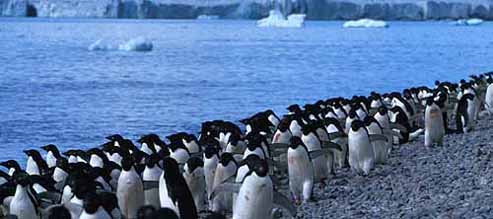
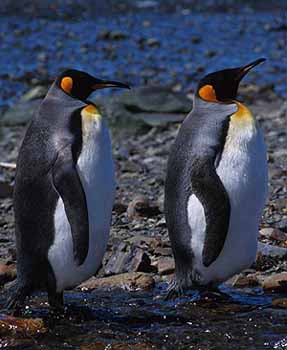
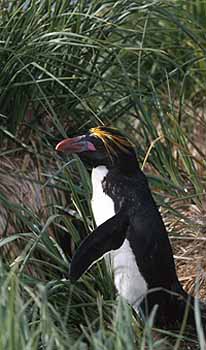
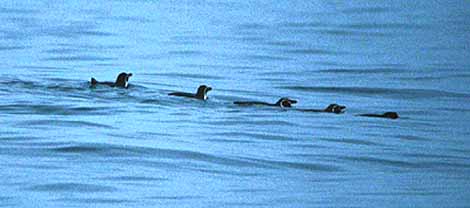 The
thought of penguins brings to mind images of "tuxedo-clad" flightless birds
standing on the Antarctic ice. But there are penguins at the Equator on
the Galapagos; those inhabiting islets off w. South America and feeding
in the rich Peru Current are the Humboldt Penguins (left). Penguins
are so different from other birds that the 17 closely-related species form
their own order, the Sphenisciformes. They are the only order of birds
that are both flightless and aquatic.
The
thought of penguins brings to mind images of "tuxedo-clad" flightless birds
standing on the Antarctic ice. But there are penguins at the Equator on
the Galapagos; those inhabiting islets off w. South America and feeding
in the rich Peru Current are the Humboldt Penguins (left). Penguins
are so different from other birds that the 17 closely-related species form
their own order, the Sphenisciformes. They are the only order of birds
that are both flightless and aquatic.
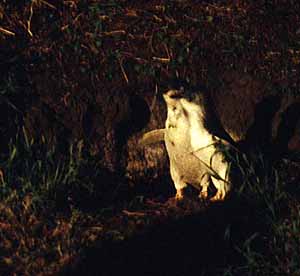
Penguins are an ancient order. There are 21 genera and 32 species known to science that are now extinct, and they show a much greater diversity in size and shape than the extant species. Penguins are highly adapted for a pelagic life; the body in streamlined with a very short neck and long flat wings used to "fly" underwater, but useless on land. In breeding colonies penguins are very noisy, and calls are individually separable, enabling partners to recognize each other and their chick with certainty (Martinez 1992). The largest penguin of them all, the Emperor Penguin Aptenodytes forsteri, is particularly unusual in egg-laying during the Antarctic winter. Males incubate the single egg on their feet in the interior of Antarctica during the frigid blasts of winter for two months!
Surely the highlight of any trip to the Antarctic continent and subantarctic
islands are the penguins. I have not yet enjoyed that experience, but my
friend Greg Lasley has been a tour leader on several cruises and has been
kind enough to allow me to post some of his photos below [more wonderful
shots are on Greg Lasley's
web site]. I've highlighted three species photographed by Greg which
show a good range of diversity in the family: a beachful of Adelie Penguins,
a couple of adult King Penguins at a colony, and an adult Macaroni
Penguin near its nest.



Photos: The Humboldt Penguins Spheniscus humboldti were swimming off the Paracas Pen., Peru, on 12 June 1987. The two Little Penguins Eudyptula minor were coming ashore on Philip I., Victoria, Australia, in Oct 1985 (B.B. Roberson). The remaining photos are by Greg Lasley: Adelie Penguins Pygoscelis adeliae at Browns Bluff, Antarctica, 22 Jan 1999; King Penguins Aptenodytes patagonicus at Grytviken, South Georgia I., on 26 Jan 1999; and Macaroni Penguin Eudyptes chrysolophus at Cooper Bay, South Georgia I., 27 Jan 1999. Photo of Humboldt Penguin © D. Roberson; photo of Little Penguin © B.B. Roberson; and remaining photos © Greg W. Lasley, respectively.
Bibliographic note:
Family book: Rating IIII ?
Williams, T. D. 1995. The Penguins. Oxford Univ. Press, Oxford.
I have not personally seen this book, but it is in the excellent Oxford Press series "Bird Families of the Word," and I have every reason to suppose it is as nicely-done as the ones I have seen (eg, Hornbills).Peterson, R. T. 1979. Penguins. Houghton Mifflin, Boston. IIII
This is an introductory book to the family but is highlighted by Roger Tory Peterson's wonderful photographs of all 17 species and their environment. Roger Peterson was known world-wide for his field guides and his paintings, but his real passion was photography and he had a keen artist's eye. This is an under-appreciated book, and even the brief text gives one a sense of "being there."Further, an excellent introduction to the family is in Martinez (1992).
Literature cited:
Martinez, I. 1992. Family Spheniscidae (Penguins) in del Hoyo, J., Elliott, A., & Sargatal, J., eds. Handbook of the Birds of the World. Vol. 1. Lynx Edicions, Barcelona.TOP